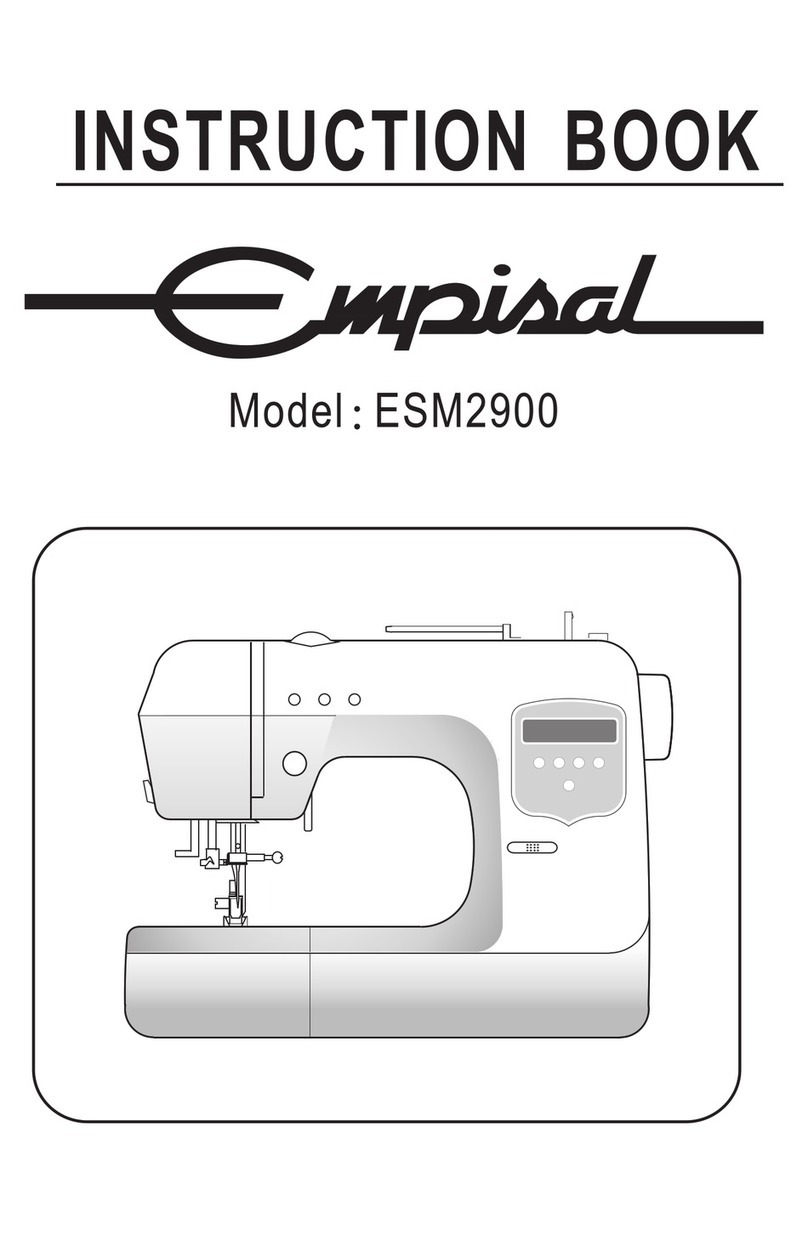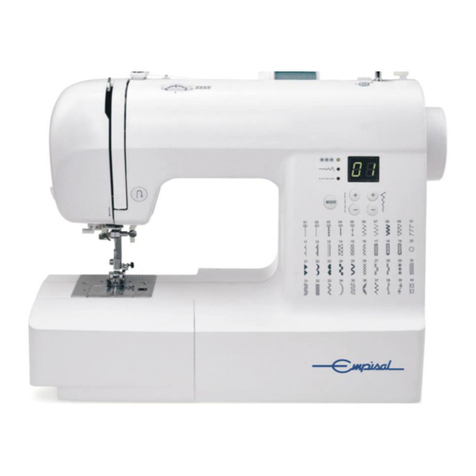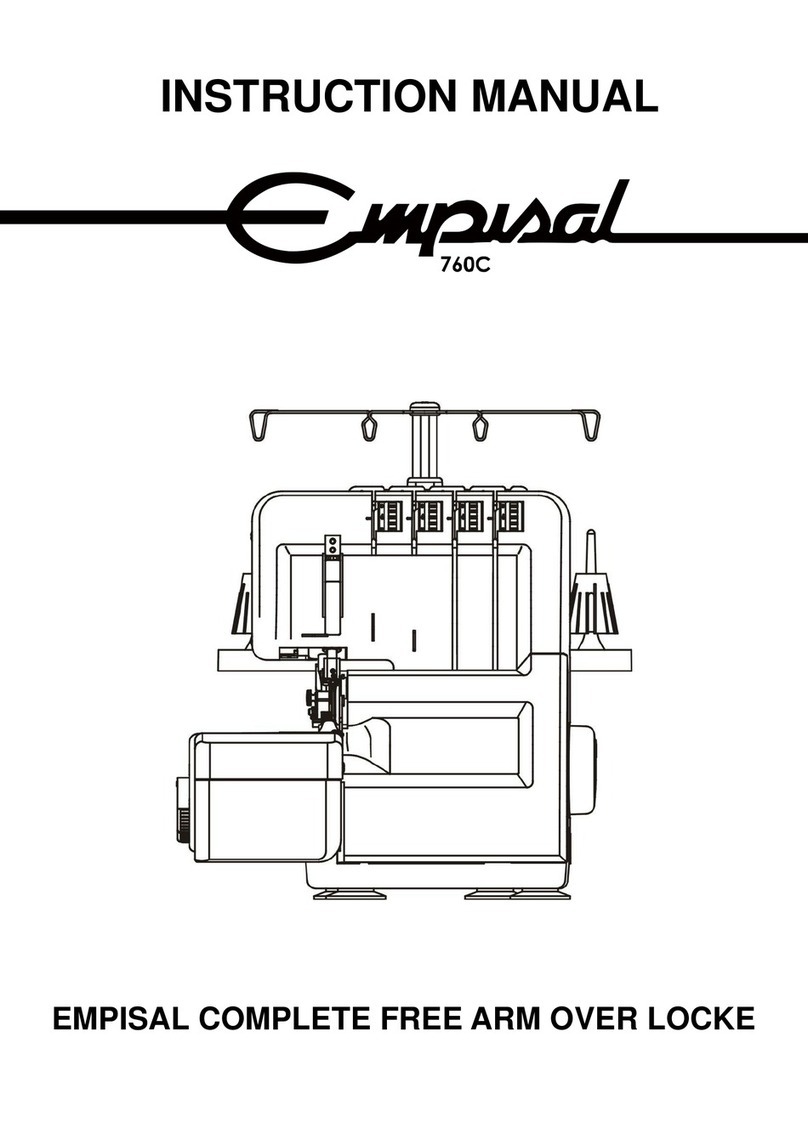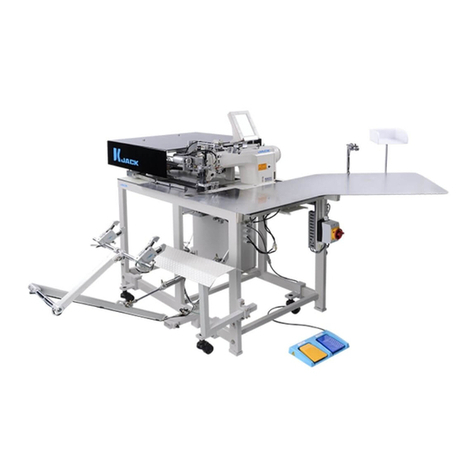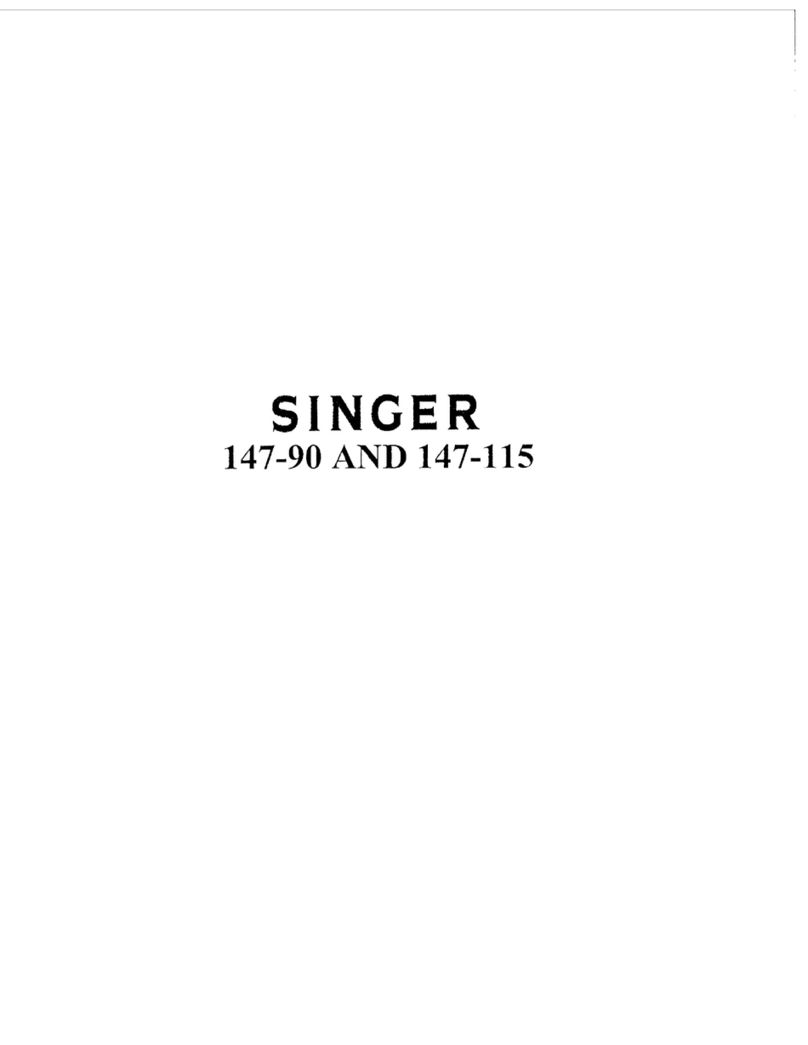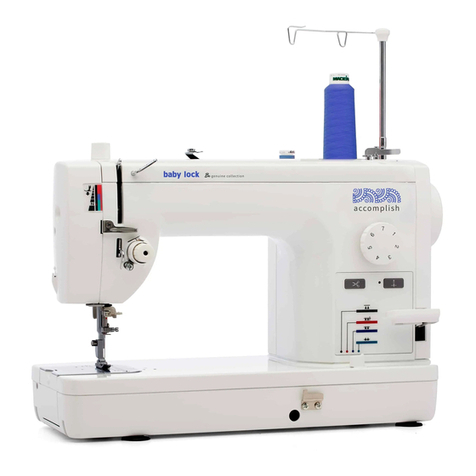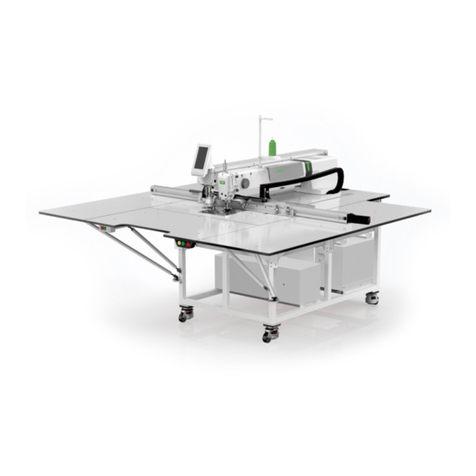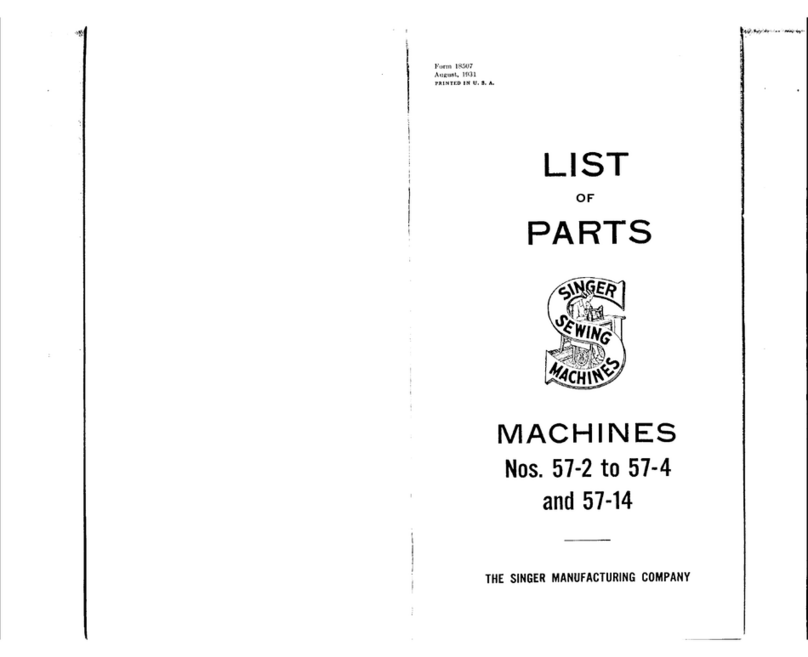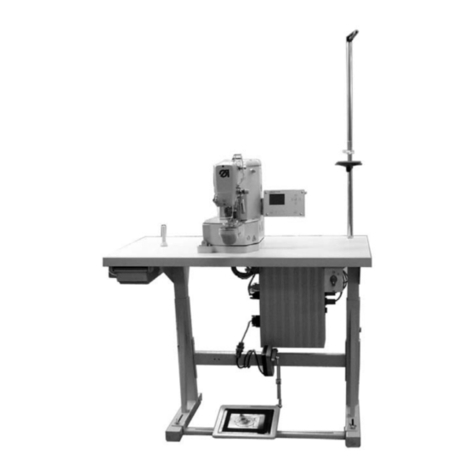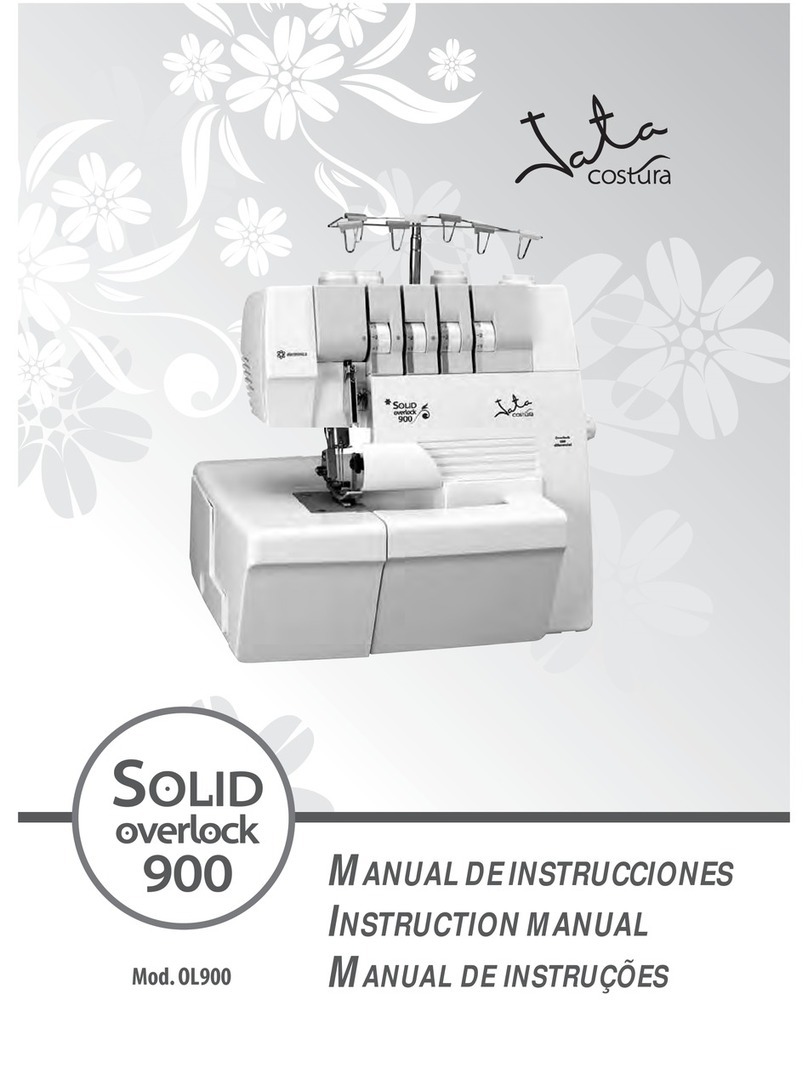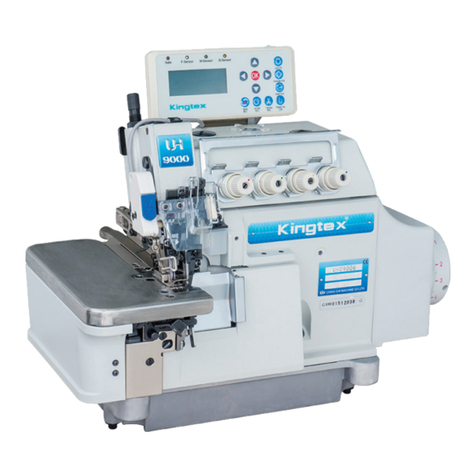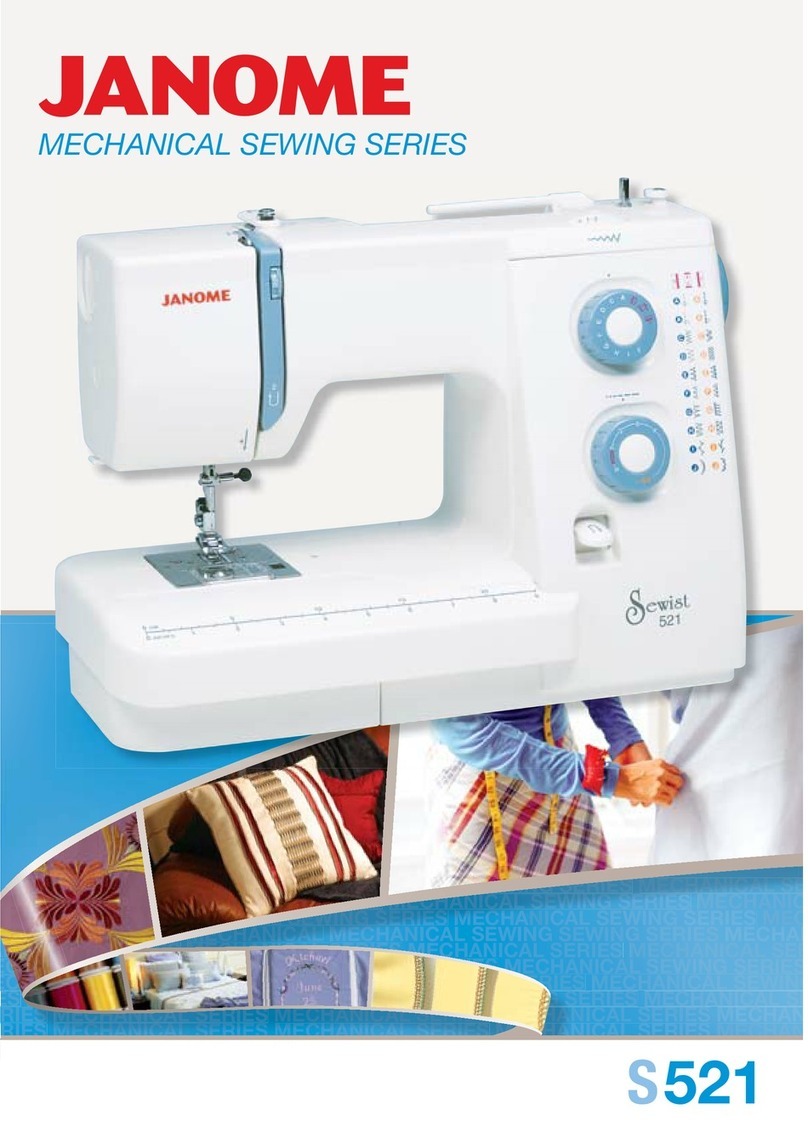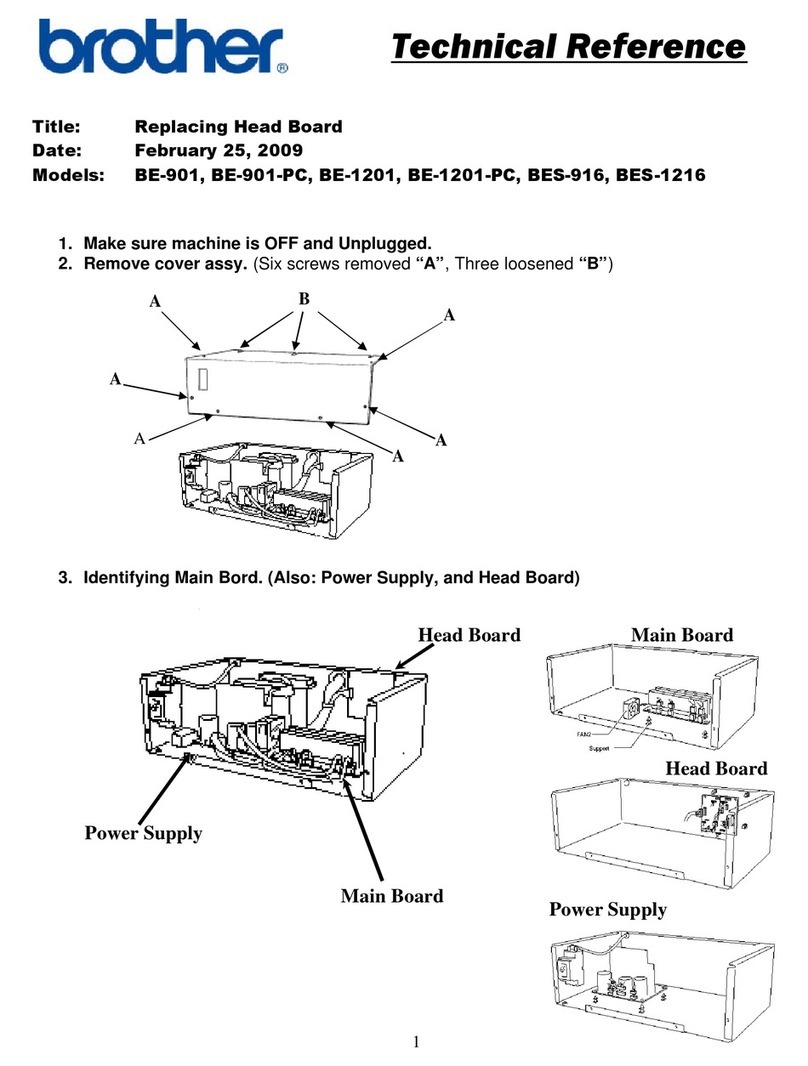Empisal Designer 800 User manual

Designer 800 Sewing Machine

Congratulations on purchasing our Empisal Designer 800 Sewing Machine.
Each unit is manufactured to ensure safety and reliability. Before using this appliance
for the first time, please read the instruction manual carefully and keep it for future
reference.
Features of the machine include:
4-step buttonhole
108 stitch functions
Adjustable stitch length: 4mm
Adjustable stitch width: 5mm
Built-in LED light
Thread tension dial
Three needle positions at right, middle or left
Shuttle hook system
Front loading bobbin
Removal extension table
Storage compartment
Thread cutter
Foldable handle
Twin needle facility
Easy changing presser foot
Needle plate with guide lines
Manual reverse lever
Power switch
Soft machine cover included
Measurement guide on machine
Adjustable pressure for presser foot
Self-uncoupling bobbin winder
Accessories included
Versatile utility stitches

IMPORTANT SAFETY INSTRUCTIONS
When using an electrical appliance, basic
safety precautions should always be followed,
including the following:
Read all instructions before using this sewing
machine.
DANGER -To reduce the risk of
electric shock:
1. This appliance should never be left
unattended when plugged in.
2. Always unplug this appliance from the
electric outlet immediately after using and
before cleaning.
WARNING -To reduce the risk of
burns, fire, electric shock, or injury to
persons:
1.
Do not allow to be used as a toy.
Close attention is required when this
appliance is used by or near children.
2.
Use this appliance only for its intended
use as described in this manual. Use only
attachments recommended by the
manufacturer as contained in this manual.
3.
Never operate this appliance if it has a
damaged cord or plug, if it is not working
properly, if it has been dropped or
damaged, or dropped into water. Return
the appliance to the nearest authorized
dealer or service centre for examination,
repair, electrical or mechanical
adjustment.
4.
Never operate the appliance with any air
openings blocked. Keep ventilation
openings of the sewing machine and foot
controller free from accumulation of lint,
dust, and loose cloth.
5.
Keep fingers away from all moving parts.
Special care is required around the sewing
machine needle.
6.
Always use the proper needle plate.
The wrong plate can cause the needle to
break.
7.
Do not use bent needles.
8.
Do not pull or push fabric while stitching. It
may deflect the needle causing it to break.
9.
Switch the sewing machine off ("0") when
making any adjustments in the needle area,
such as threading needle, changing needle,
threading the bobbin, or changing presser
foot, and the like.
10.
Always unplug sewing machine from the
electrical outlet when removing covers,
lubricating, or when making any other user
servicing adjustments mentioned in the
instruction manual.
11.
Never drop or insert any object into any
opening.
12.
Do not use outdoors.
13.
Do not operate where aerosol spray
products are being used or where oxygen
is being administered.
14.
To disconnect, turn all controls to the off
("0") position, then remove plug from
outlet.
15.
Do not unplug by pulling on cord. To
unplug, grasp the plug, not the cord.
SAVE THESE
INSTRUCTIONS
This sewing machine is intended for household
use only.

List of contents
Parts diagram.................................................................................................................................................................................2-3
Accessories.................................................................................................................................................................................... 4
Fitting the snap-in sewing table and spool pin ·········································································································5
Connecting machine to power source.···················································································································6
Two-step presser foot lever/ Adjusting the presser foot pressure.·················································································7
Attaching the presser foot holder.·························································································································8
Winding the bobbin......................................................................................................................................................................... 9
Inserting bobbin............................................................................................................................................................................... 10
Changing the needle·········································································································································11
Threading the upper thread.································································································································12
Thread tension.................................................................................................................................................................................13
Bringing up the lower thread ·······························································································································14
Reverse sewing/ Removing the work/ Cutting the thread.···························································································15
Matching needle I fabric I thread. ·························································································································16
How to choose your pattern. ·······························································································································17
Straight stitching and needle position ····················································································································18
Zigzag sewing.·················································································································································19
How to sew 4-step buttonholes. ···························································································································20
3-step zigzag.··················································································································································21
Stitch selection.················································································································································22
Smocking stitch················································································································································23
Practical stitches··············································································································································24
Darning··························································································································································25
Attaching lace··················································································································································26
Applique·························································································································································27
Twin needle.....................................................................................................................................................................................28
Patch work.......................................................................................................................................................................................29
Maintenance ···················································································································································30
Trouble shooting guide…………………………………………………………………………………………………………………….31-32
Storing and servicing the machine························································································································33
Warranty.......................................................................................................................................................................................... 34

2
Parts diagram
1.
Thread tension dial
2.
Presser foot pressure
3.
Thread take-up lever
4.
Thread cutting
5.
Presser foot
6.
Needle plate
7.
Sewing table and accessory box
8.
Bobbin stopper
9.
Stitch length dial
10.
Stitch width dial
11.
Stitch display
12.
Reverse sewing lever

3
Parts Diagram
13.
Upper thread guide
14.
Presser foot lever
15. Handle
16.Bobbin winder
17.Spool pin
18.Handwheel
19 Pattern selector dial
20.
Power switch
21.
Main plug socket
22.
Bobbin thread guide

4
Accessories
Standard accessories
a.
4-step Buttonhole foot
b.
Butterfly shape screwdriver
c.
Seam ripper/brush
d.
Lubricate oil
e.
Needle x 3 pcs
f.
Bobbins x 3 pcs
g.
Twin needle
h.
Screwdriver(small)
i.
Screwdriver(large)
j. Edge/Quilting guide
k. Embroidering plate
I. Spool holder
m.
All-purpose foot

5
Fitting the snap-in sewing table and spool pin
Fitting the spool pin
Hold the snap-in sewing table horizontal, and push it in the
direction of the arrow. (1)
The inside of the snap-in sewing table can be utilized as an
accessory box.
To open, lift up at the point of the arrow. (2)
Install The Spool pin
1.
Take out the spool pin from
the poly foam.
2.
Loosen the screw M4X18
as shown.
3.
Install the spool pin as
illustrated then tighten the
screw.

6
Connecting machine to power source
Caution:
Always make sure that the machine is unplugged from the power
source and the main switch is on "OFF" when the machine is not in
use and before inserting or removing parts.
-
This machine is equipped with a polarized plug which must be
used with an appropriate electrical outlet.
-
Connect the machine to a power source as illustrated (1&2).
-
The power switch is located above the terminal box. Your
machine will not operate unless this switch is on" I ". (1}
-
The sewing light turns on automatically when the main switch is on
"I".
-To start the machine, press the foot control (3}.The speed
of the machine is regulated by the amount of pressure
exerted on the foot control.
Attention:
Consult a qualified electrician if in doubt as to connect machine to
power source. Unplug power cord when machine is not in use.
Only the supplied foot control should be used with this
machine, use of any other control will void the warranty.

7
Two-step presser foot lever
When sewing several layers or thick fabrics, the presser
foot can be raised to a second stage for easy positioning of
the work. (A)
Adjusting the presser foot pressure
The presser foot pressure of the machine has been pre-set
and requires no particular readjustment according to the
type of fabric (light-or-heavy weight).
However, if you need to adjust the presser foot pressure, turn the
presser foot pressure dial as shown to the left.
For sewing very thin fabric, loosen the pressure by
turning the dial counter clockwise, and for heavy
fabric, tighten by turning it clockwise.

8
Attaching the presser foot holder
•Attention:
Turn the power switch to "OFF" before carrying out any of the operations
below.
Raise the needle to its highest position and raise the presser foot
lever. Attach the presser foot holder (b) to the presser foot bar (a). (1)
Attaching the presser foot:
Lower the presser foot holder (b) until the cut-out (c) is directly above
the pin (d). (2)
Lower the presser foot holder (b) and the presser foot (f) will engage
automatically.
Removing the presser foot:
Raise the presser foot.
Release the pressure foot by raising lever (e) located at the back of the
foot holder. {3)
Attaching the seam guide:
Attach the seam guide (g) in the slot as illustrated. Adjust the
distance as required for hems, pleats, etc..... (4)

9
Winding the bobbin
..................
·--- ----...........
Place an empty bobbin on the bobbin winder spindle.
Take the thread from the spool through the bobbin winder
tension disc. (1)
Wind the thread a few times by hand around the empty bobbin
in a clockwise direction. Push the bobbin to the right towards
the bobbin winding position. (2)
Press the foot control gently. The bobbin will stop winding
when it is full. Push the bobbin to the left to "sewing position"
and remove it.
•
Please Note:
When the bobbin winder spindle is in
"bobbin winding" position, the machine
will not sew and the hand wheel will not
turn. To start sewing, push the bobbin
winder spindle to the left (sewing
position).
a. Spool pin

Inserting the bobbin
■Attention:
Turn power switch to "OFF" before inserting or removing the bobbin.
When inserting or removing the bobbin, the needle must be fully raised.
Open the hinged cover. (1)
Hold the bobbin case with one hand. Insert the bobbin so that the thread
runs in a clockwise direction (arrow). (2)
Pull the thread through the slot, down and to the left until it enters the
delivery eyelet (rectangular opening) under the tension spring. (3)
Hold the bobbin case by the hinged latch. (4)
Insert the bobbin case fully into the shuttle race and release the latch.
Make sure that the metal finger fits into the notch at the top of the race
cover. (5)
10

Changing the needle
■ Caution:
Turn power switch to "OFF" before
inserting or removing the needle.
Replace the needle at the first sign of
thread breakage or skipped stitches.
Select the correct type and size of needle
for the fabric to be sewn. Turn the balance
wheel towards you until the needle is at its
highest position. Loosen the needle clamp
screw (A) and tighten again after inserting
the new needle. (1)
The flat side of the needle shaft should be
facing away from you (B). Push the
needle up (C) into the needle clamp as far
as it will go (D).
Tighten the needle clamp screw firmly.
The sewing needle must always be
straight and sharp for smooth sewing.
Replace the needle (2) if it is bent (A),
blunt (B) or the point is damaged (C).
11

12
Threading the upper thread
Caution:
Before threading, turn power switch
to "OFF".
Raise the needle bar to its highest
position. Follow exactly the numbered
threading sequence illustrated below.
If you skip a step or fail to properly
engage the thread in any of the
thread guides, the machine will not
sew properly. (1-5)
Continue to draw the thread down
and into the needle bar thread guide.
Insert the thread through the eye of
the needle from front to back. Leave
about 10 cm (4") of thread loose
behind the needle. (6)
a. Spool pin
b. Spool holder

13
Thread tension
Note:
The bobbin thread tension has
been adjusted at the factory and
readjustment is usually not
required.
Lower thread tension
To test the bobbin thread tension,
remove the bobbin case and bobbin
from the machine and hold the
bobbin case suspended by the
thread. Shake it once or twice. If the
tension is correct, the thread will
unwind by about an inch or two. If
the tension is too tight, it will not
unwind. If the tension is too loose,
the thread will unwind for more than
two inches.
To adjust, turn the small screw on
the side of the bobbin case. (1)
Upper thread tension
Basic thread tension setting: "4". (2)
To increase the tension, turn the dial up to a higher number. To reduce the tension, turn the dial to
a lower number.
A.
Normal thread tension.
B.
Thread tension too loose.
C.
Thread tension too tight.

14
Bringing up the lower thread
Hold the upper thread with the left hand.
Turn the handwheel towards you with your
right hand until the needle goes down and
comes up again to its highest position. (1)
-Lightly draw the needle thread forming a
loop with the bobbin thread. The upper
thread should have caught the lower
thread in a loop.
-
Pull the needle thread toward you and
the lower thread will come up from the
bobbin in a large loop. (2)
Pull about 15 cm. (6") of both threads
away from you under the presser foot.

15
Reverse sewing
Removing the work
Reverse sewing is used for locking the end of seams and where
reinforcement is needed. At the end of seam, press down the
reverse sewing lever and touch the foot control lightly. Sew a few
reverse stitches. Release the lever and the machine will sew
forwards again (A).
Turn the handwheel towards you to bring the thread take up lever
to its highest position. Raise the presser foot and draw the fabric
away from you.
Cutting the thread
Hold the threads behind the presser foot. Using both hands, guide
them to the slit (B) at the rear of the presser bar and press down
to cut the thread. You can also use the thread cutter on the side of
the machine.

16
Matching needle I fabric I thread
NEEDLE, FABRIC, THREAD SELECTION GUIDE
NEEDLE SIZE
FABRICS
THREAD
9-11(65-75)
Lightweight fabrics-thin cottons, voile,
serge, silk, muslin, Oiana, interlocks,
cotton knits, tricots, jerseys, crepes,
woven polyester, shirt & blouse
fabrics.
Light-duty thread in cotton,
nylon or polyester.
12(80)
Medium weight fabrics-cotton, satin,
kettleclote, sailcloth, double knits,
lightweight woollens.
Most threads sold are medium
size and suitable for these
fabrics and needle sizes. Use
polyester threads on synthetic
materials and cotton on natural
woven fabrics for best results.
Always use the same thread on
top and bottom.
14(90)
Medium weight fabrics-cotton duck,
woollen, heavier knits, terrycloth,
denims.
16{100)
Heavyweight fabrics-canvas, woollens,
outdoor tent and quilted fabrics,
denims, upholstery material (light to
medium).
18(110)
Heavy woollens, overcoat fabrics,
upholstery fabrics, some leathers and
vinyls.
Heavy duty thread, carpet
thread. (Use heavy foot
pressure -large numbers.)
IMPORTANT: Match needle size to thread size and weight of fabric
NEEDLE, FABRIC SELECTION
NEEDLES
EXPLANATION
TYPE OF FABRIC
HA x 1
15 x 1
Standard sharp needles.
Sizes range thin to large.
9 (65) to 18 (110)
Natural woven fabrics-wool, cotton, silk, etc.
Qiana. Not recommended for double knits.
15 x
1/705H
(SIN)
Semi-ball point needle,
scarfed 9 (65) to 18 (110)
Natural and synthetic woven fabrics, polyester
blends. Knits-polyesters, interlocks, tricot,
single and double knits. Can be used instead
of 15 x 1 for sewing all fabrics.
15 x 1/705 HS
(SUK)
Full ball point needle 9
(65) to 18 (110)
Sweater knits, Lycra, swimsuit fabric, elastic.
130 PCL
Leather needles. 12 (80)
to 18
(110)
Leather, vinyl, upholstery. (Leaves smaller
hole than standard large needle.)
Note:
1. Twin needles, can be purchased for utility and decorative work.
2. When sewing with twin needles, the stitch width dial should be set at less than "2.5".
3. European needles show sizes 65, 70, 80 etc. American and Japanese needles show size 9, 11,
12 etc.
4. Replace needle often (approximately every other garment) and I or at first thread breakage or
skipped stitches.

17
How to choose your pattern
For straight stitch select pattern "A"
with pattern selector dial (4). Adjust
the stitch length with the stitch
length dial (2). You may choose any
needle position, by turning the stitch
width dial (1).
For zigzag stitch, select pattern "B"
with pattern selector dial (4). Adjust
the stitch length (2) and stitch width
{1) according to the fabric being
used.
To obtain any of the patterns on the
upper row, turn the stitch length dial
to "S2", select the pattern desired
with pattern selector dial, and adjust
the stitch width with the stitch width
dial.
To obtain any of the patterns on the
second row, turn the stitch length
dial to "S 1", select the pattern
desired with pattern selector dial,
and adjust the stitch width with the
stitch width dial.
To obtain any of the other patterns
shown in the third row on the stitch
selection panel, select the letter
above the stitch with the pattern
selector dial. Adjust the stitch length
and the stitch width with the control
dials according to the result desired.
1. Stitch width dial
2. Stitch length dial
3. Stitch display
4. Pattern selector dial
5. Reverse sewing lever
Table of contents
Other Empisal Sewing Machine manuals
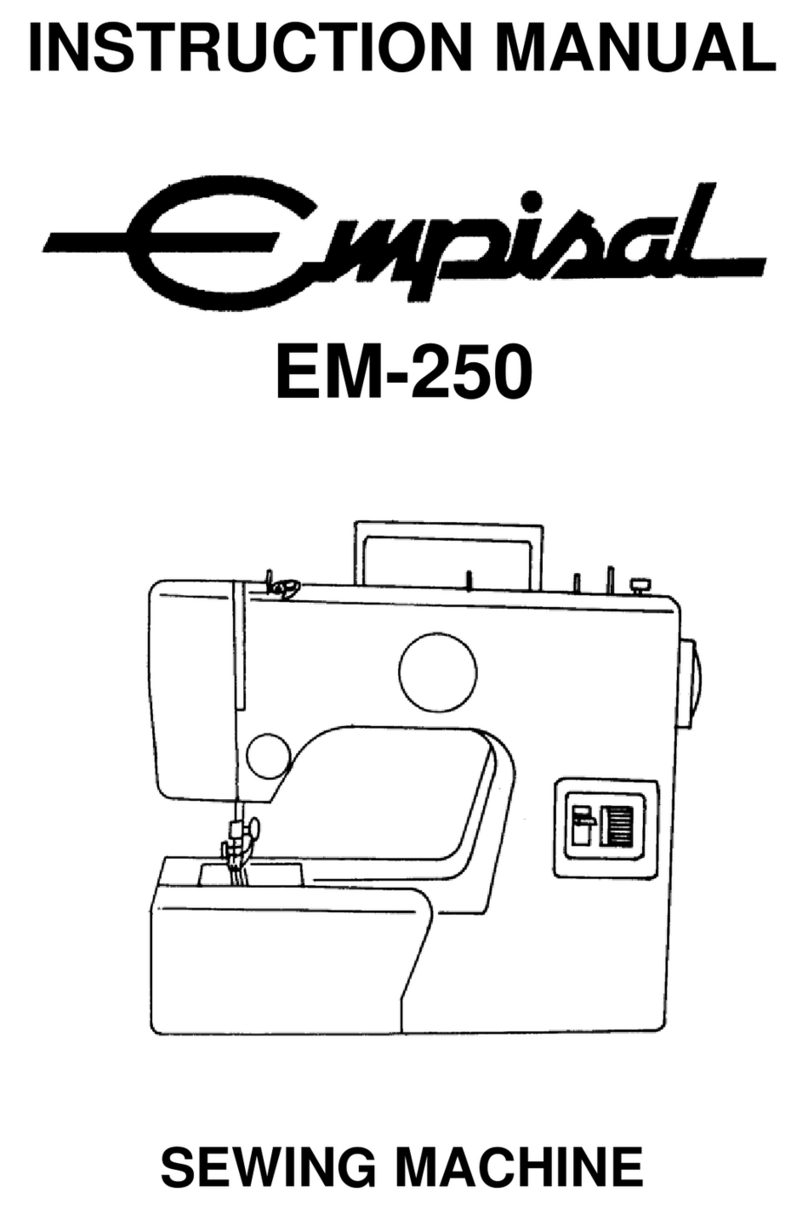
Empisal
Empisal em-250 User manual
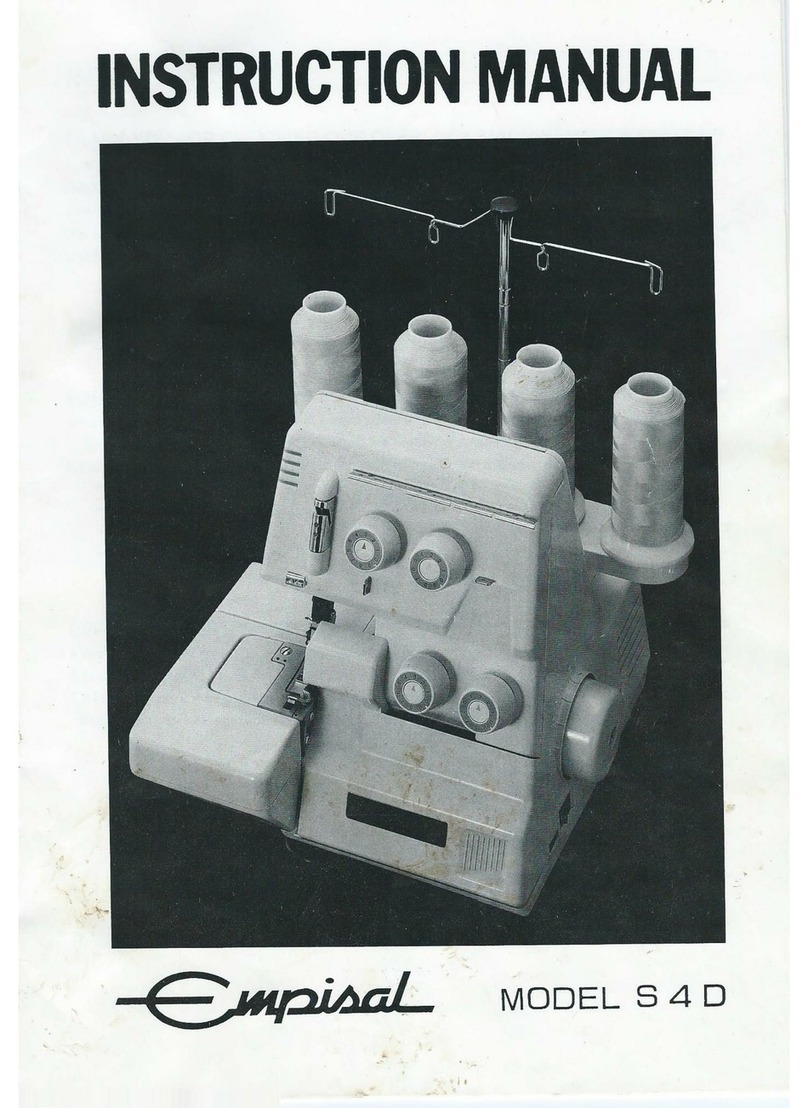
Empisal
Empisal S4D User manual
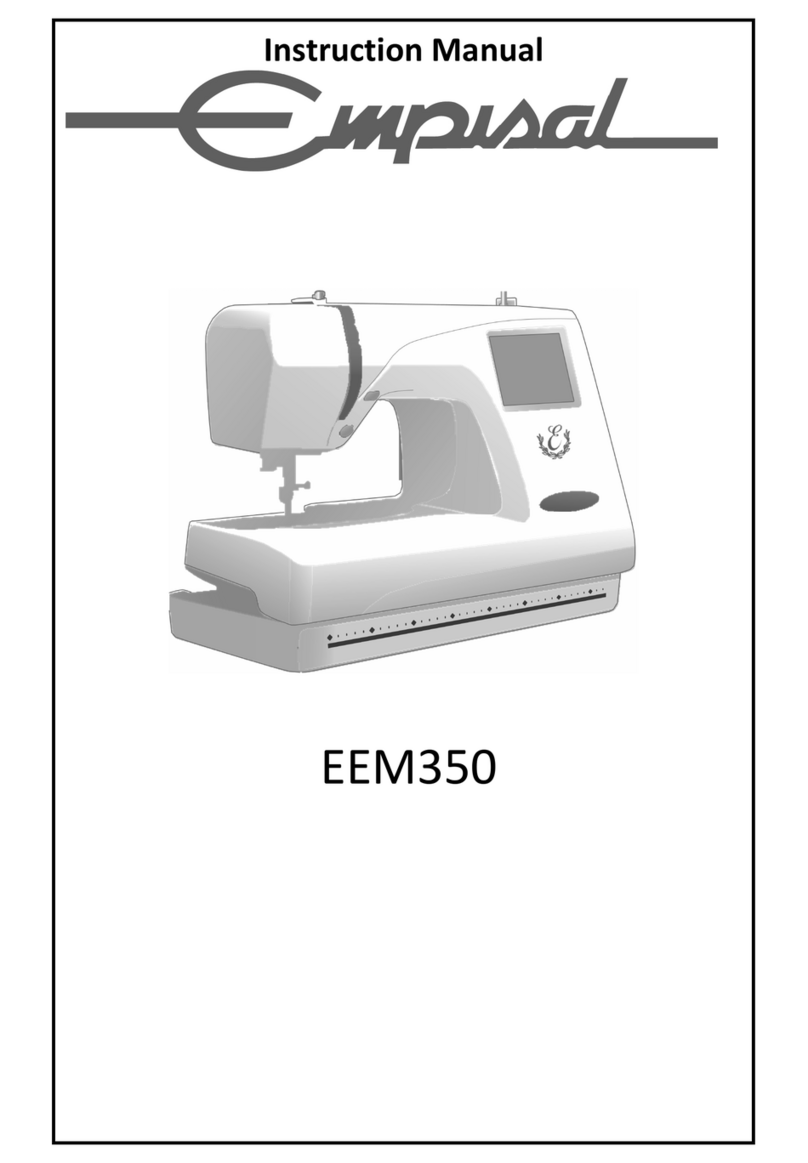
Empisal
Empisal EEM350 User manual
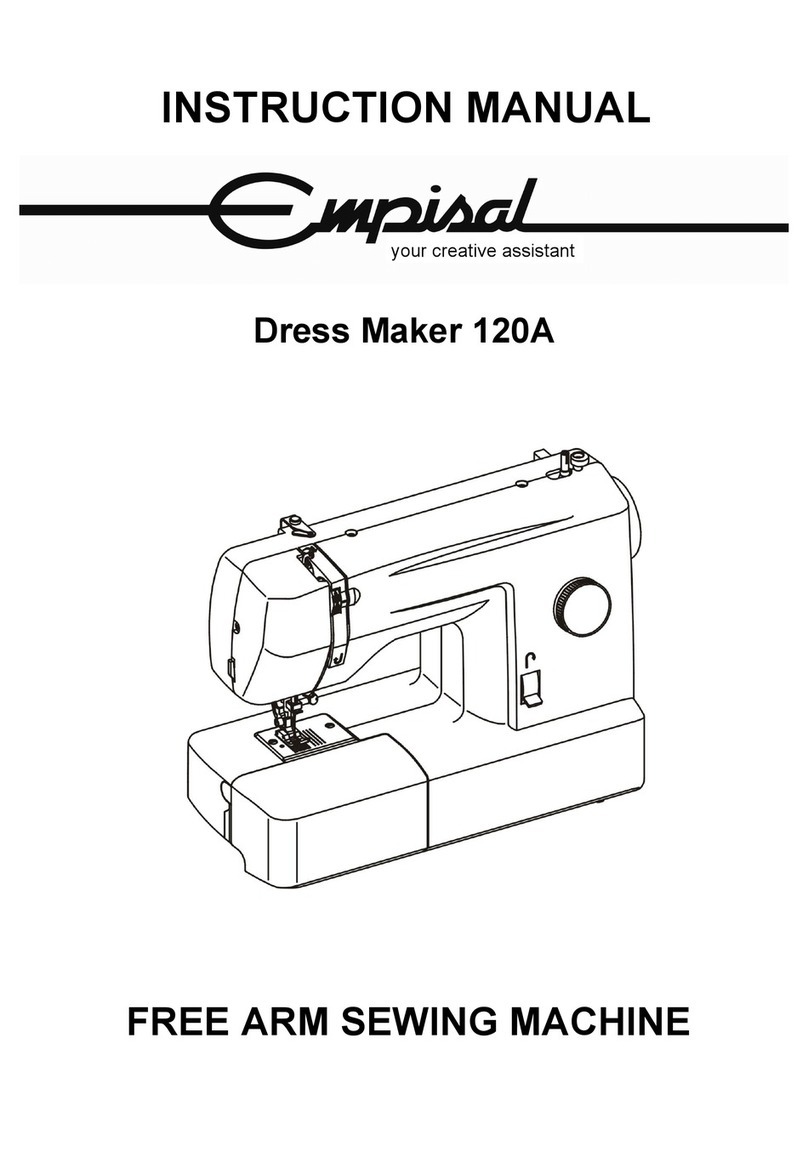
Empisal
Empisal Dress Maker 120A User manual
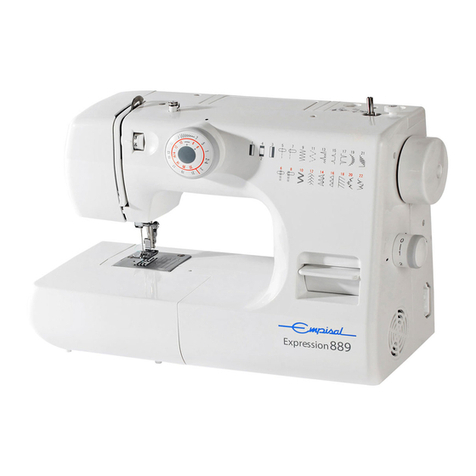
Empisal
Empisal Expression 889 User manual
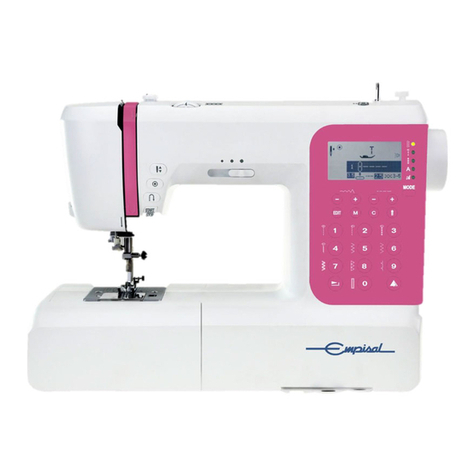
Empisal
Empisal EES50 User manual
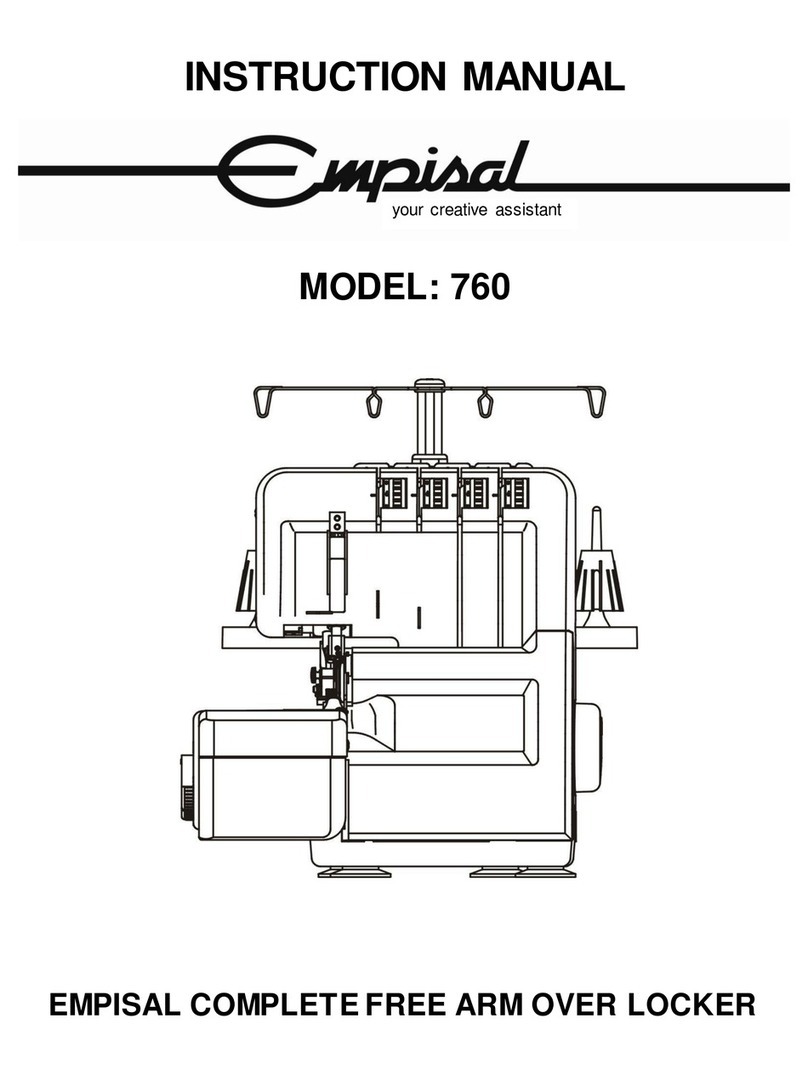
Empisal
Empisal 760 User manual

Empisal
Empisal EEMC220 User manual
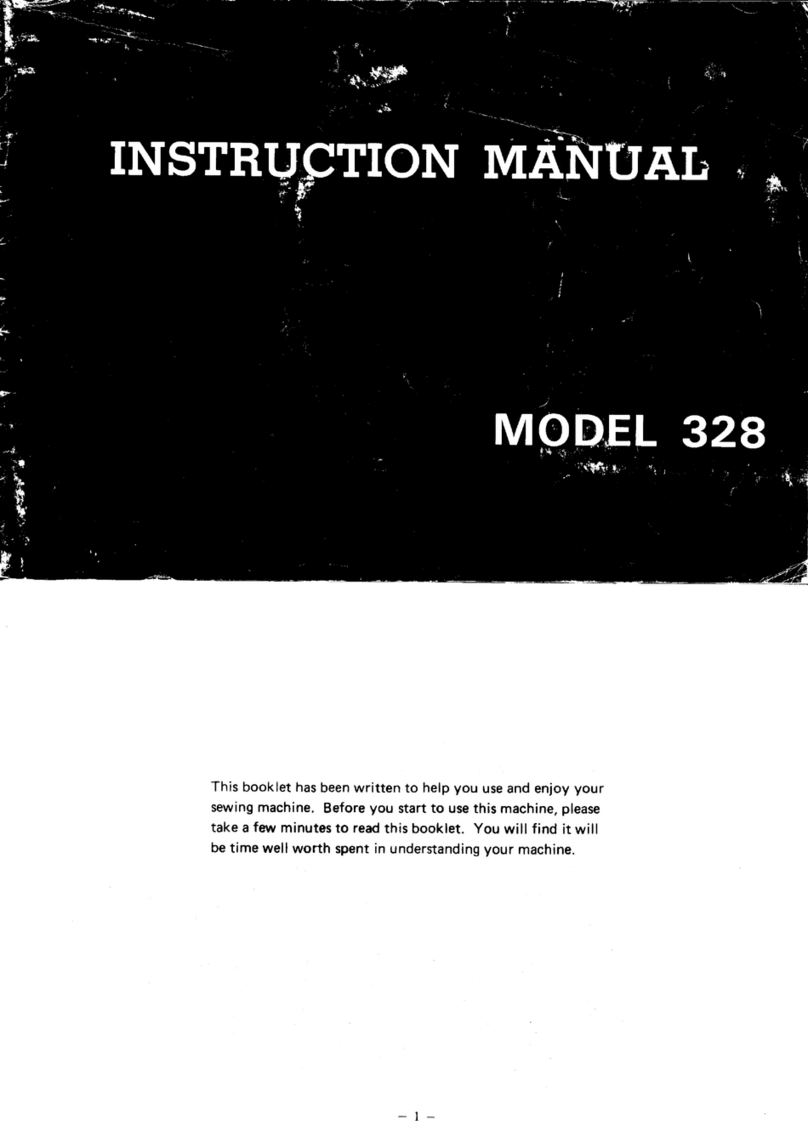
Empisal
Empisal Heidi 328B User manual
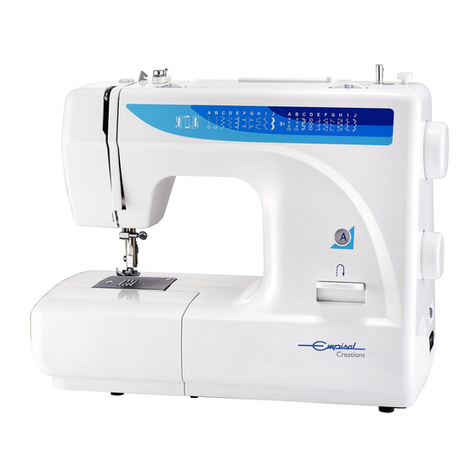
Empisal
Empisal creations User manual

